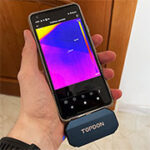The thermal cameras are usually very expensive, but the Topdon TC001 aims to change that, giving more people access to this awesome technology, especially during the current energy crisis.
| Topdon TC001 | |
|---|---|
| Topdon.com | Check Product |
| Amazon.com | Check Product |
It’s not secret that FLIR has been dominating the ‘more affordable’ thermal camera market (yes, there are far more expensive devices out there), but you’d still need to burn through at least $500 for the entry-level model (the One Pro), so seeing that the Topdon TC001 currently costs way less than that while promising more has obviously caught my attention. Indeed, the TC001 thermal camera promises a better image quality than its competitors thanks to the 256x192p resolution and the 25Hz frame rate.
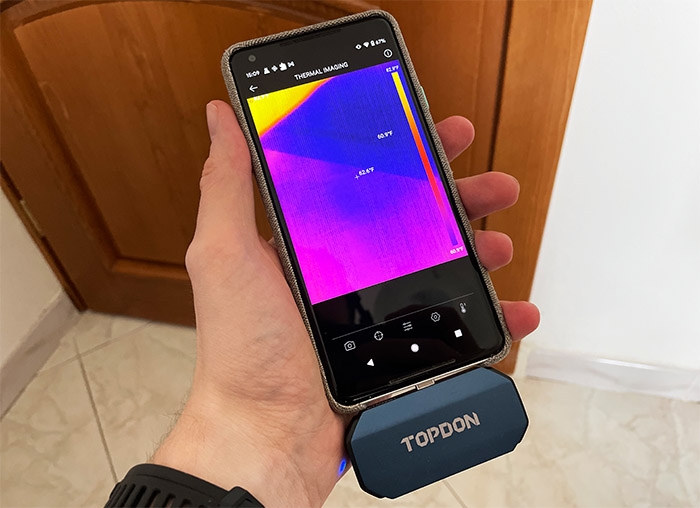
Most are stuck at 9Hz due to US regulations and yes, you will see a difference between low and high frame rate – the latter is better, obviously. The Topdon TC001 does not have a built-in battery, so it does need to rely on the smartphone to be powered up, but we’ll soon put it to the test and see just how energy efficient it actually is (the power consumption is advertised at 0.25W). Furthermore, the thermal camera is currently available only for Android (USB-C), but I do expect that an iPhone version is in the works.
That being said, know that the Topdon TC001 is not the only thermal camera in this price range since the Seek Compact series is also an attractive option, so let’s see if the TC001 can outdo its competitors.
Design and Build Quality
Every type of module that gets to be attached to a smartphone needs to be as compact as possible and, ideally to be at least a bit rugged, including the USB-C connector which should be reinforced (somehow). The good news is that the Topdon TC001 is actually very compact, measuring only 2.80 x 1.65 x 0.55 inches (7.1 x 4.2 x 1.4cm), which means that it’s very similarly sized to the FLIR One Pro (2.7 x 1.3 x 0.6in), but a bit larger than the SEEK Compact model (1.75 x 1.0 x 0.8 inches). Also, at 1.06oz, it’s not going add any noticeable weight to the smartphone.
Topdon TC001 vs FLIR One Pro vs SEEK Compact
Topdon TC001
FLIR One Pro
SEEK Compact
Resolution
256x192p
160x120p
206x156p
Frame Rate
25Hz
9Hz
9Hz
Battery
None – relies on phone
350mAh
None – relies on phone
Spot Meter
Yes
Yes
Yes
MSX (or alternative)
No
Yes
No
| Topdon TC001 | FLIR One Pro | SEEK Compact | |
| Resolution | 256x192p | 160x120p | 206x156p |
| Frame Rate | 25Hz | 9Hz | 9Hz |
| Battery | None – relies on phone | 350mAh | None – relies on phone |
| Spot Meter | Yes | Yes | Yes |
| MSX (or alternative) | No | Yes | No |
In terms of design, it tries to mimic the shape of the lower section of a phone which I think is a better design that the SEEK thermal cameras. And the case has a metallic outer shell with some plastic inserts which partially cover the frame of the Topdon TC001, mostly at the top, to offer some protection to the USB-C port. And it’s worth mentioning that the developers did think about thick cases, kind of. The USB-C connector rises above the case up to 0.4in which means that you should be able to get a connection even when the phone uses a case.
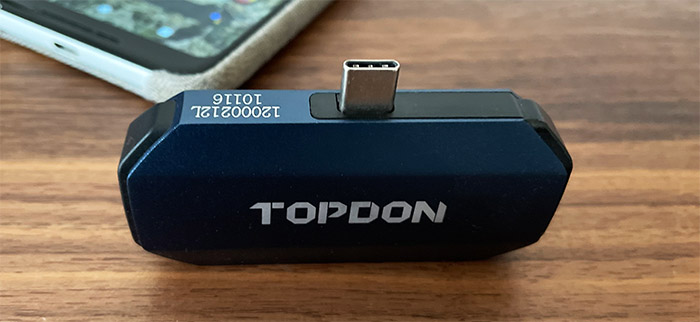
At least in my case it did just fine with multiple phones (and cases). I did see that inside the pouch that’s provided in the package, there was a USB-A to USB-C cable, so you can connect the Topdon TC001 thermal camera to a Windows machine, such as a laptop. Of course, the main area of interest is the camera which sits on the side of the case and it is slightly recessed as to not risk breaking due to mechanical shocks.
I did mention in the intro that at the moment, there is only a USB-C option, but I am fairly sure they will release a version for the iPhone as well – maybe they’re just waiting to see if Apple will actually accept defeat and move to the USB-C standard, like everyone else. Also, the case is covered by a blue matte finish and no other color is currently available.
The Installation
The hardware installation involves connecting the Topdon TC001 thermal camera to an Android phone which will power it up but, to see the image, you do need to install the app. I searched Topdon in the Play Store and there is a dedicated one for the TC001, so there is no general app for multiple products.
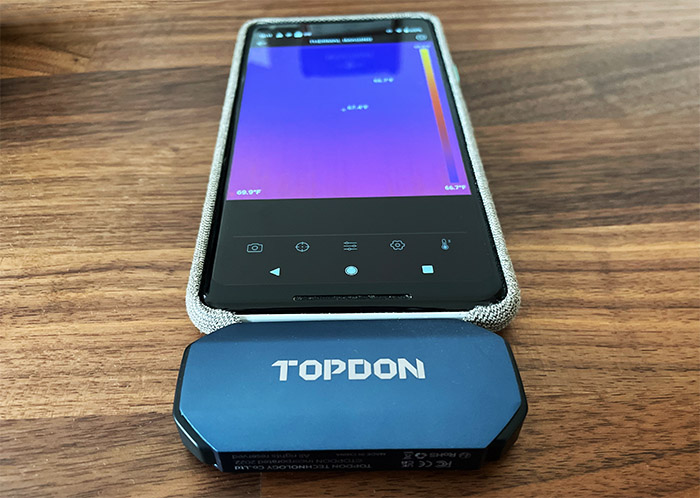
After installing it on an Android phone, the app asked if I agreed to the Terms of Services and the Privacy Policy, so I decided to check what data is being collected. It seems to be device-related info (such as software and hardware version), some battery info, your location (I suggest you restrict it, since I see no reason for it) and there is some other personal info via data profiling, identification analysis and more to generate characteristic tags for personalized services and content (no idea how this involves the thermal camera).
I assume this is a general policy for all Topdon devices and not everything applies to the TC001. That being said, after accepting the aforementioned policies, I was asked for access to the camera and media, which makes sense, followed by the request that I connect the thermal camera. After attaching the module, the camera appeared as being connected and online (the side LED also started shining blue).
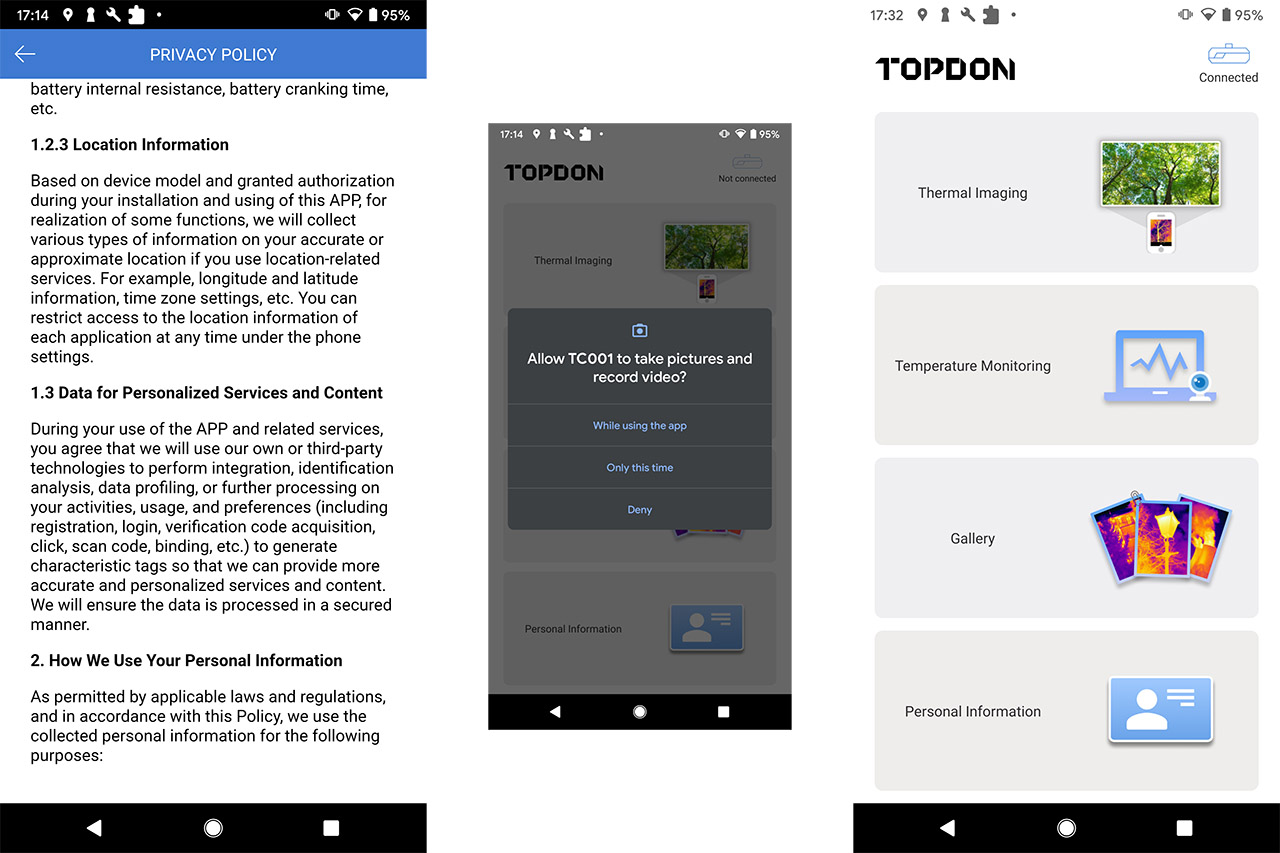
The Mobile Application
The main page of the app shows four tabs that you can access, the first being the Thermal Imaging, followed by Temperature Monitoring, Gallery and Personal Information. I wanted to brush off the last section, but know that here you can calibrate the thermal sensor and switch between Celsius and Fahrenheit. The Gallery section is obvious, so let’s check out the Thermal Imaging. As anticipated, here’s where you can check the temperature of your surroundings and there are a few interesting options that you can use from the bottom-placed menu.
Besides the photo/video tab, you can choose a certain point on the screen to show the temperature, but it’s also possible to draw an area where you can check the degrees. Then, you can choose the color palette, as well as adjust some various options which include rotating the view, setting the details and contrast level, as well as setting temperature limits. What’s interesting is that there is an Image in Image section which I assume would be an alternative to overlay that FLIR does which partially shows the actual picture along the thermal map.
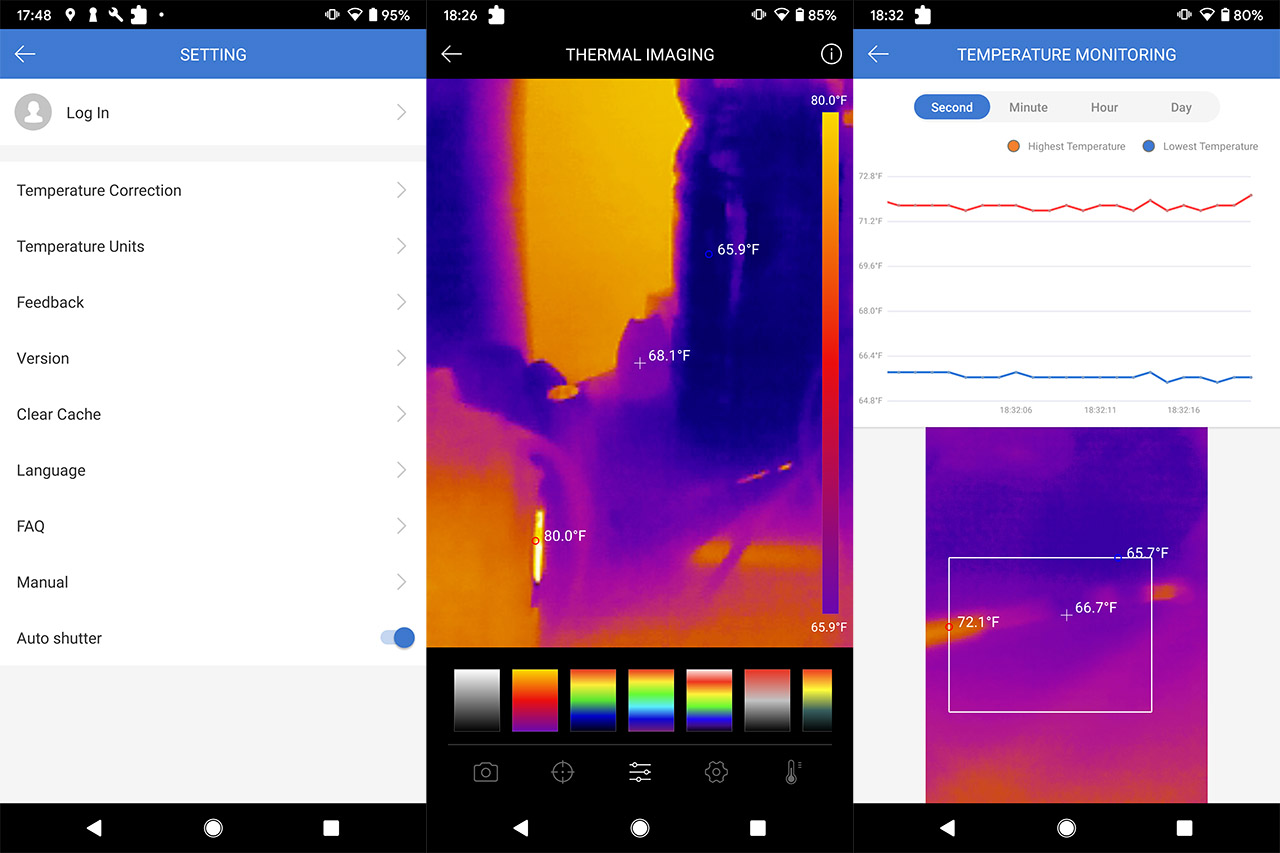
I am not sure it works that well to be honest, but I suppose that it’s better than nothing. Lastly, you can manually select the temperature range or simply let the camera recognize the correct range by itself.
The Temperature Monitoring section does exactly what you would expect, it monitors the changes in terms of temperature of a specific spot that you pointed the camera at. It will create a live graph that you can check at any time and this way, you can analyze if there’s a faulty circuit or any other similar application.
The Topdon TC001 in action: Quality, clarity and accuracy
The thermal camera sensor used by the Topdon TC001 has a pixel size of 12μm and a resolution of 256×192 pixels which is higher than the 160x120p resolution of the FLIR One Pro and a bit better than the 206 x 156 pixels of the SEEK Compact. It’s interesting to see that the AGM Glory Pro thermal camera supports the same exact resolution and I do have it available for a comparison. But before that, I also need to mention the 25Hz which goes beyond the 9Hz limit of both the FLIR One Pro and the SEEK Compact, but it’s the same as on the Glory Pro.
How come its competitors are limited in this regard? The thermal cameras that are made in the US can be exported without a license as long as they has the frame rate less or equal to 9Hz. Since both Topdon and AGM are built outside the US, they can push the refresh rate a lot higher and it shows. I have captured a video of both AGM Glory Pro and the Topdon TC001 side by side (sort of) and the result was interesting.
Note: I need to mention that on the left, there’s the AGM Glory Pro, the TC001 being on the right. Since the left footage was slowed down by AGM, I had to cut some parts to make it match with the Topdon TC001. Also, the freezes that you see on the right side are not video cuts, it’s just the TC001 recalibrating.
The 25Hz refresh rate definitely makes a difference since the movements are smoother and not like a quick PowerPoint presentation. But I have noticed a very weird behavior from AGM. I put the two videos side by side, but despite being filmed at the same time, one was longer than the other. For some weird reason, the Glory Pro increases the length of the video, like a slight slow motion. My guess is the processing power, but I am not entirely sure what’s their deal. The Topdon TC001 thermal camera, on the other hand seems quick and reactive to changes, but there is a clicking sound along the occasional freeze.
Apparently, the reason for that is the continuous calibration of the sensors and it seems to be normal for module-type thermal cameras. Now let’s talk about the accuracy of the temperature. Topdon says that the maximum temperature variance can be 2 degrees C, down to 0.1 C, while the potential thermal error should be less than 1.8 F if the target temperature is below 212 degrees F. I didn’t have an instrument which I could trust to be perfectly accurate, just the AGM Glory Pro to compare its results.
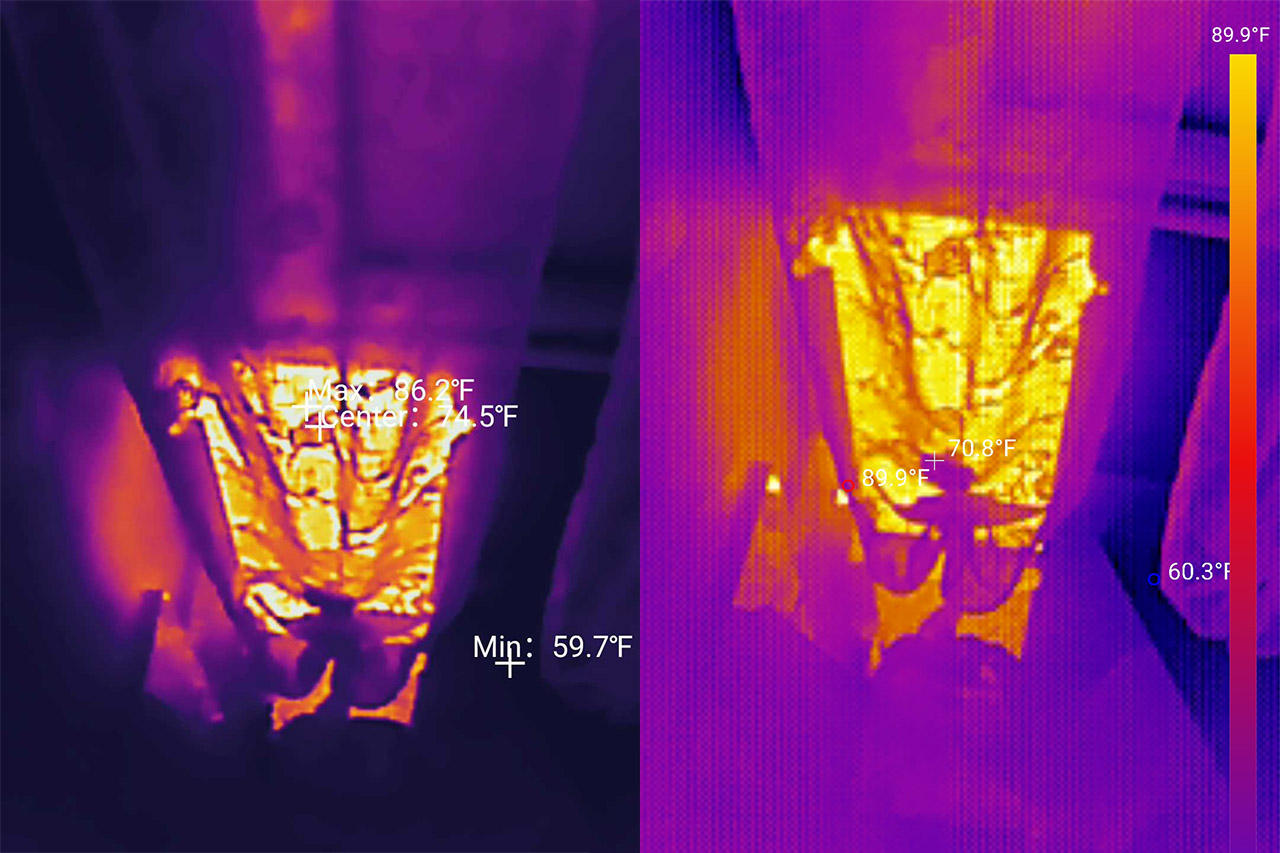
And, as you can see from the photos, in some cases, the values are very similar, like 1 or 2 degrees F of difference only, but if you check the stove, you can see that the hottest point differs by about 20F.
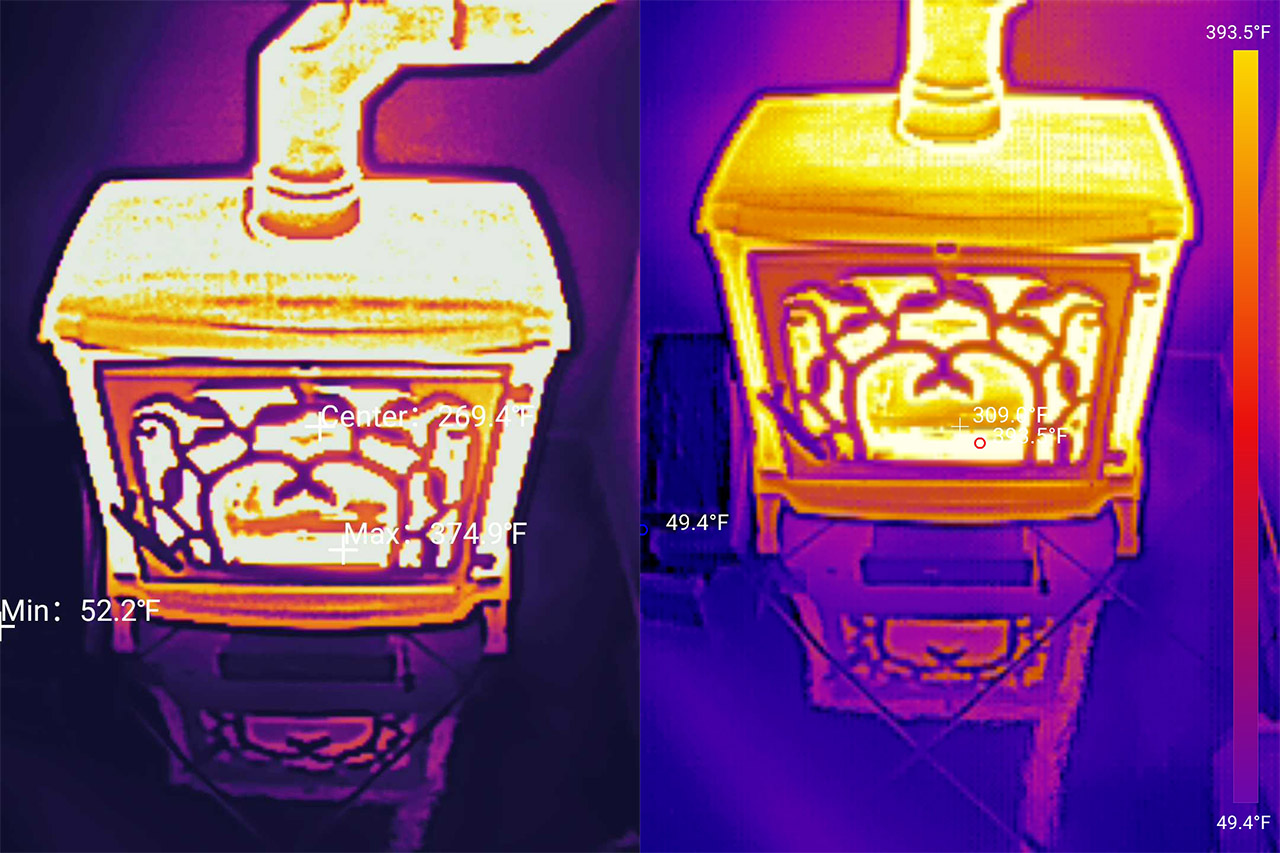
Some differences can also be seen in the coach photo, but not that significant, so, for the lack of a proper point of reference, I say that both cameras were very close to what the actual temperature of the objects actually was.
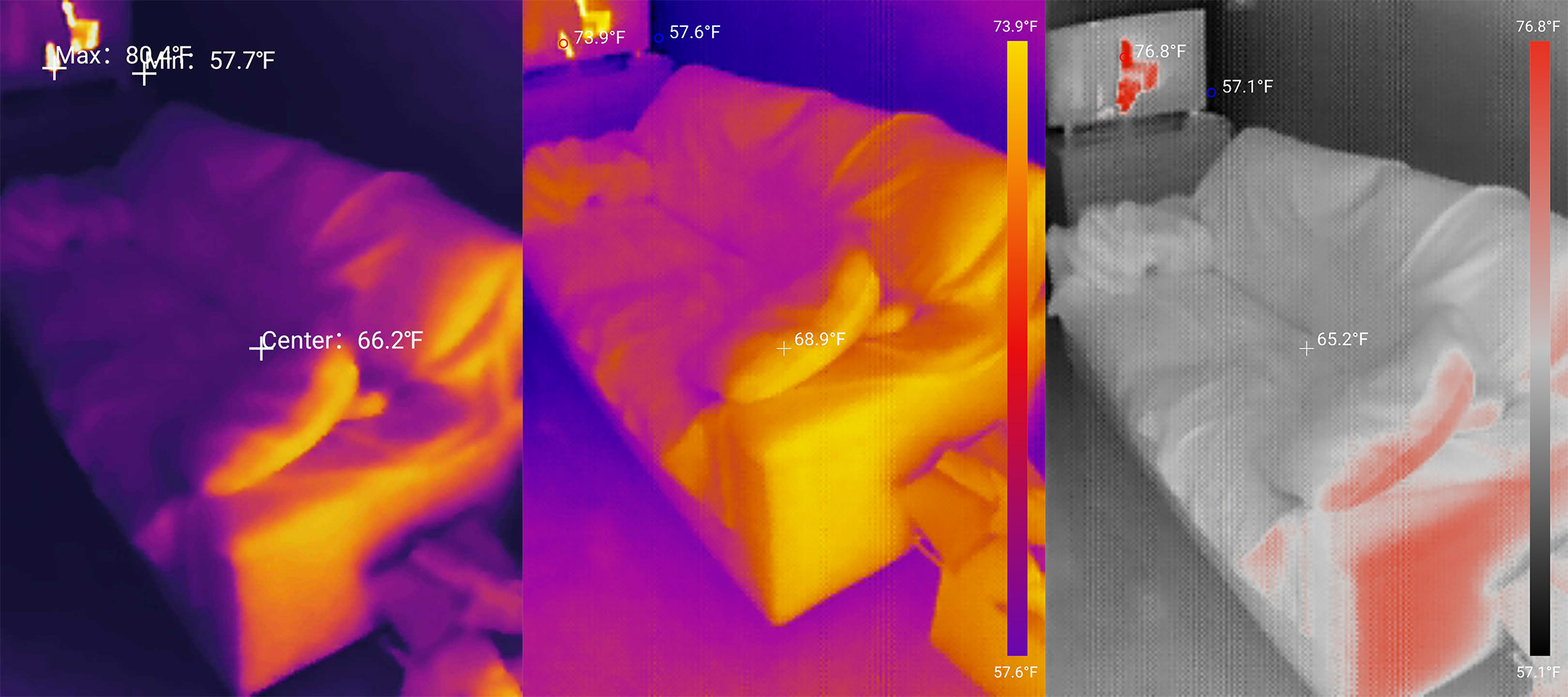
Let’s also talk about image clarity and quality. Again, I am going to compare the photos to https://www.mbreviews.com/agm-glory-pro-rugged-smartphone-review/the AGM Glory Pro and I could immediately tell that the Topdon TC001 is brighter and reacts a bit more to heat than the Glory Pro which tends to darken the colder spots a bit more. Also, I think that the Glory Pro is a bit more clear in regards to surface heat distribution, as seen on the door photos.
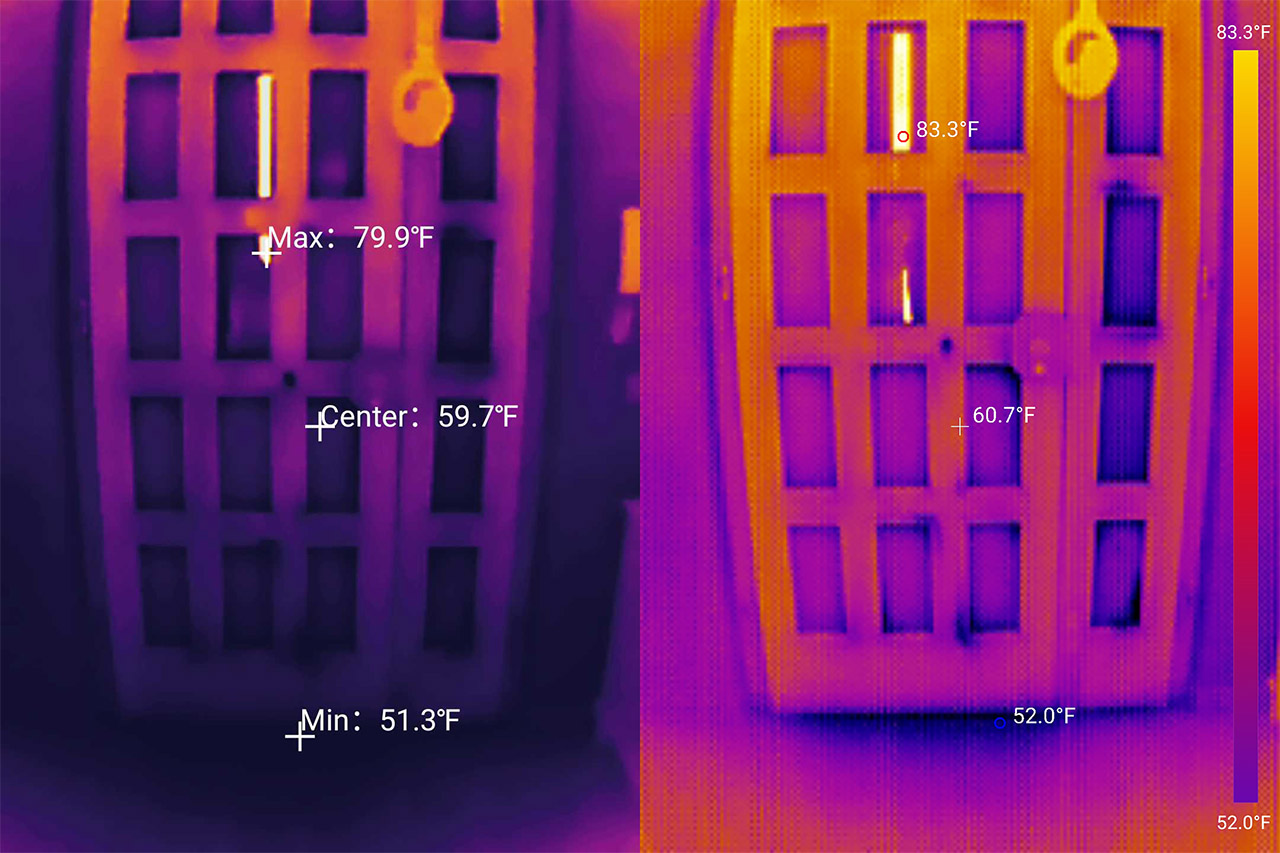
At the same time, checking the stove photos, the darker areas did hid some details on the Glory Pro, while the Topdon TC001 did show them and they were well defined. One advantage that the TC001 has is the ability to change the color palette so, for example, I used the gray and red nuances which seems to show a lot more detail than before, matching the performance of the Glory Pro for the most part. I also tried the image-in-image feature and the view became very confusing – also, if I wanted to take a photo of the overlaid photos, only the thermal one appeared (unless I screenshoted the image). Overall, I am not a fan of this mode.
Modular vs all-in-one thermal camera
The main complaints that people have about the module-type thermal cameras include the annoying constant calibration (which is something that happens with the Topdon TC001), the reliance of the USB port, which may lead to the module either slipping out or breaking, and there have been complaints about loss of connection, which I found a bit strange, but possible. The TC001 is not going to fall out of the phone due to both the properly-made connector and the low weight of the module, while the loss of connection is unlikely when it’s done via the USB port.
At the same time, using a separate thermal camera module allows the device to use the processing power of the smartphone, which may have been too much a few years ago, but not now, when we get specs that rival inexpensive laptops. Also, another advantage is the battery life which depends again, on the phone, instead of a built-in one.
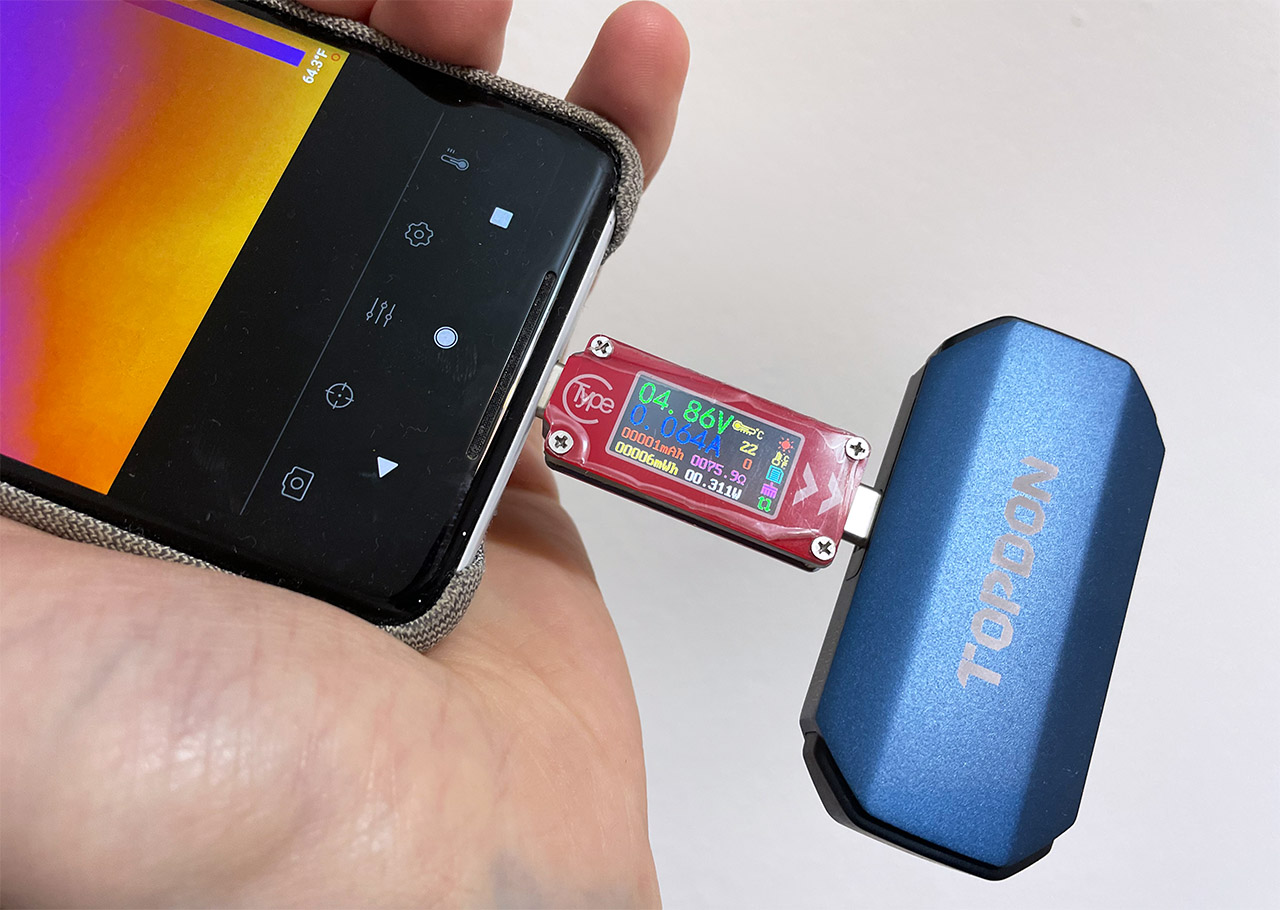
And you may think that the latter is better, but, looking at FLIR’s approach where the rechargeable inner battery would often fail, shows that using the smartphone battery may not be such a bad idea after all. Also, let’s see the power consumption of the Topdon TC001 since I was skeptical about the advertised 0.25W. My small multi-meter shows an average of 0.31W which is a bit above the advertised value, but still an almost negligible amount considering the actual performance of the thermal camera.
Another interesting point to be made in favor of the modular thermal cameras is that they don’t use their own display which may be outdated or small. Instead, you get to enjoy the entire screen of your smartphone.
The Conclusion
It’s nice to see the thermal cameras getting more affordable, making them available for a larger audience and not just for a select few. And the Topdon TC001 does offer an overall more compelling package than the FLIR One, in some areas going above the entry-level SEEK camera as well. There’s the 25Hz refresh rate and the relatively high resolution plus all the useful features in the app (zone selection, color palette). The image overlay is kind of there, but I don’t like their implementation at all, so I do consider this to be the TC001’s main weakness. Other than that, this is a very good thermal camera for the price and if you have an Android phone, you should definitely give the Topdon TC001 a chance.

Mark is a graduate in Computer Science, having gathered valuable experience over the years working in IT as a programmer. Mark is also the main tech writer for MBReviews.com, covering not only his passion, the networking devices, but also other cool electronic gadgets that you may find useful for your every day life.

